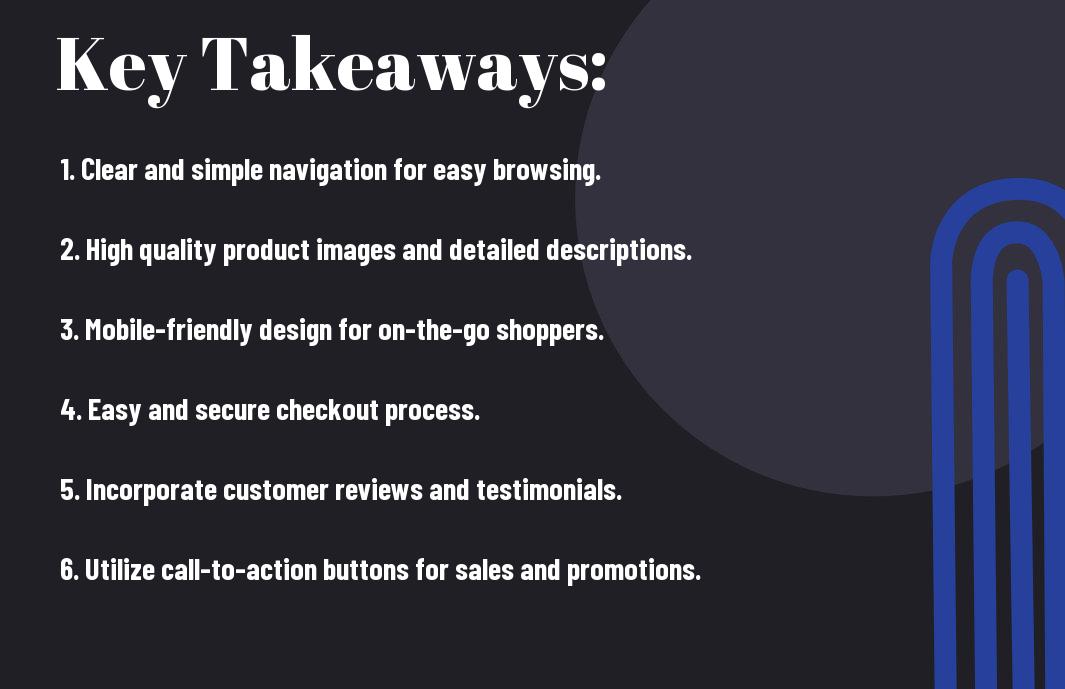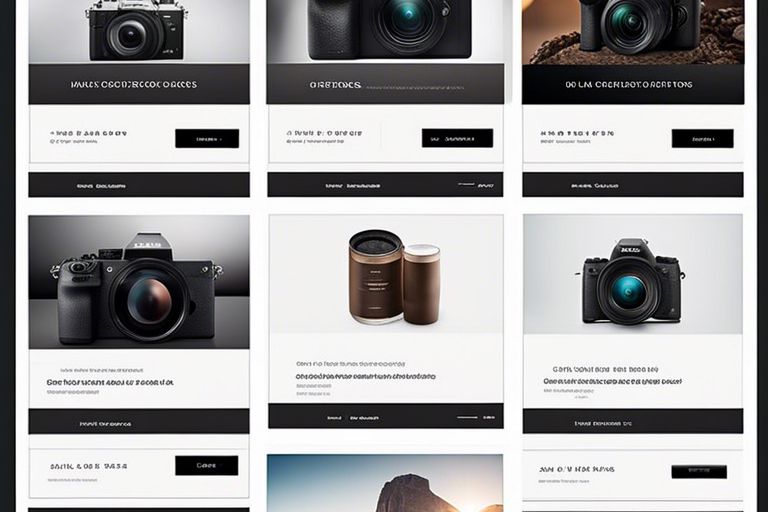Creating an e-commerce website can be a daunting task, but with the right strategies, you can ensure that your website not only attracts visitors but also converts them into paying customers. Your website’s design plays a crucial role in influencing the purchasing decisions of your potential customers, so it’s important to pay close attention to the details. Optimizing your website for conversions and sales requires careful planning and execution. In this blog post, we will discuss some essential tips for designing an e-commerce website that effectively drives conversions and sales, helping you to achieve your business goals.
Key Takeaways:
- User-Friendly Interface: Creating a clean and intuitive design will help users navigate the website easily, leading to increased conversions and sales.
- Mobile Optimization: Ensuring the website is fully responsive and optimized for mobile devices will capture a larger market share and enhance the overall user experience.
- Clear Call-to-Actions: Implementing clear and compelling CTAs will guide users towards making a purchase, improving conversion rates.
- High-Quality Imagery and Content: Utilizing high-resolution images and engaging content will draw in potential customers and encourage them to explore products further.
- Streamlined Checkout Process: Simplifying the checkout process and offering various payment options will reduce cart abandonment and increase sales.

Understanding Your Audience
Clearly, understanding your audience is crucial when designing an e-commerce website that drives conversions and sales. You need to know who your target market is and what their behavior and preferences are when it comes to online shopping. To get a better idea of your audience, you can refer to resources such as E-commerce Web Design Tips to Drive Sales and Increase Conversions for valuable insights and tips.
Identifying Your Target Market
Identifying your target market is the first step in understanding your audience. This involves researching and gathering data on the demographics, psychographics, and buying behavior of your potential customers. By knowing who your customers are, you can tailor your website design and content to better cater to their needs and preferences.
Catering to Consumer Behavior
Understanding consumer behavior is essential for designing an e-commerce website that drives sales and conversions. You need to analyze how your target audience interacts with online platforms, what influences their purchasing decisions, and what factors drive them to complete a purchase. By catering to consumer behavior, you can create a user-friendly and intuitive website that encourages visitors to make a purchase.
Key Design Elements
After reading “22 Best UX Tips to Increase Your E-commerce Conversions“, you now know the importance of focusing on key design elements to drive conversions and sales on your e-commerce website. These elements play a crucial role in creating a positive user experience, which can ultimately lead to increased sales and customer loyalty.
User-Friendly Navigation
When designing your e-commerce website, it’s important to prioritize user-friendly navigation. Your customers should be able to find what they’re looking for quickly and easily. Use clear and intuitive menus, product categories, and filters to help users easily navigate through your website and find the products they want. Additionally, incorporating a search bar at a prominent location on your website can further enhance the user experience by allowing customers to search for specific products.
Responsive Design for Mobile Users
In today’s tech-savvy world, more and more people are using their mobile devices for online shopping. Therefore, it’s essential to ensure that your e-commerce website is optimized for mobile users. A responsive design ensures that your website adapts to different screen sizes, providing a seamless shopping experience across all devices. By prioritizing a mobile-friendly design, you can cater to a larger audience and avoid losing potential customers due to a poor mobile experience.
High-Quality Product Images
The visuals of your products play a significant role in influencing purchasing decisions. High-quality product images allow your customers to get a clear and detailed view of the items you are selling. By including multiple images from different angles and zoom-in capabilities, you can provide a comprehensive view of your products, instilling confidence in your customers’ purchasing decisions.
Effective Call-to-Action Buttons
Your call-to-action (CTA) buttons are crucial in guiding your website visitors towards making a purchase. Whether it’s a “Buy Now” button or “Add to Cart,” it’s crucial to make these buttons stand out on your website. Use contrasting colors, strategic placement, and compelling copy to draw attention to your CTA buttons. Additionally, make sure they are easily clickable and responsive across different devices, ensuring a frictionless checkout process for your customers.
By focusing on these key design elements, you can create a user-friendly and visually appealing e-commerce website that encourages conversions and drives sales. Keep in mind that paying attention to these details can make a significant impact on your overall e-commerce performance. Ensuring user-friendly navigation, responsive design, high-quality product images, and effective call-to-action buttons are imperative for boosting your e-commerce conversions and sales.
Building Trust and Credibility
Unlike physical stores where customers can interact with products before making a purchase, e-commerce websites require a high level of trust from the customer. Building trust and credibility with your online audience is crucial to driving conversions and sales. If your e-commerce website is perceived as untrustworthy, potential customers are likely to abandon their carts and look for alternatives. To ensure that your website is a trusted destination for online shoppers, there are several strategies you can implement.
Incorporating Social Proof
One effective way to build trust and credibility on your e-commerce website is by incorporating social proof. Displaying customer reviews, testimonials, and ratings on your product pages can help reassure potential customers of the quality and reliability of your products. When visitors see positive feedback from other customers, it can alleviate any doubts they may have and increase their confidence in making a purchase.
Ensuring Secure Transactions
When shopping online, customers are concerned about the security of their personal and financial information. To build trust and credibility, it’s essential to prioritize the security of transactions on your e-commerce website. Implementing secure payment gateways and prominently displaying trust badges and security certifications can give your customers peace of mind when making a purchase. By assuring customers that their sensitive information is protected, you can instill confidence and encourage them to complete their transactions.
Driving Sales and Conversion Optimization
Now that you have designed an attractive and user-friendly e-commerce website, it’s time to focus on driving sales and optimizing conversion rates. This is crucial for the success of your online business, and there are various strategies you can implement to achieve this.
Streamlining the Checkout Process
When it comes to converting website visitors into customers, a seamless checkout process is essential. A complicated or lengthy checkout process can result in cart abandonment, ultimately costing you sales. Ensure that your checkout process is efficient and user-friendly. For example, implementing a guest checkout option, minimizing the number of form fields, and offering multiple payment options can significantly improve the overall experience for your customers and increase conversion rates.
Implementing A/B Testing for Continuous Improvement
Implementing A/B testing on your e-commerce website allows you to continuously improve and optimize various elements to drive sales and increase conversions. By testing different versions of product pages, call-to-action buttons, and checkout processes, you can gather valuable data on what resonates with your audience and what drives sales. This data-driven approach will help you make informed decisions to improve the overall performance of your website and ultimately increase your conversion rates.

Conclusion
From above tips we talked about, you now have a solid understanding of how to design an e-commerce website that drives conversions and sales. By focusing on user experience, mobile optimization, clear calls to action, and streamlined checkout processes, you can create a website that effectively converts visitors into customers. Remember to continuously analyze and optimize your website based on user behavior and feedback to ensure that it continues to drive sales and grow your business. Implement these strategies, and you’ll be well on your way to building a successful e-commerce platform that effectively drives conversions and boosts your bottom line.
FAQ
Q: Why is designing an e-commerce website important for driving conversions and sales?
A: Designing an e-commerce website effectively can improve user experience, build trust with customers, and ultimately lead to higher conversion rates and increased sales.
Q: What are some key tips for designing an e-commerce website that drives conversions and sales?
A: Some key tips include optimizing the website for mobile use, implementing clear and intuitive navigation, utilizing high-quality images and visuals, and ensuring seamless checkout processes.
Q: How can mobile optimization impact website conversions and sales?
A: With an increasing number of consumers using mobile devices for online shopping, ensuring that your e-commerce website is optimized for mobile can lead to higher engagement, lower bounce rates, and ultimately more conversions and sales.
Q: Why are high-quality images and visuals important for an e-commerce website?
A: High-quality visuals can help showcase products in the best light, provide a more engaging and immersive shopping experience for customers, and build credibility for your brand, ultimately leading to higher conversion rates and sales.
Q: What are some best practices for optimizing the checkout process on an e-commerce website?
A: Optimizing the checkout process involves minimizing the number of steps, offering guest checkout options, displaying clear and transparent pricing, and providing multiple payment options to streamline the buying process and reduce cart abandonment, resulting in increased conversions and sales.
